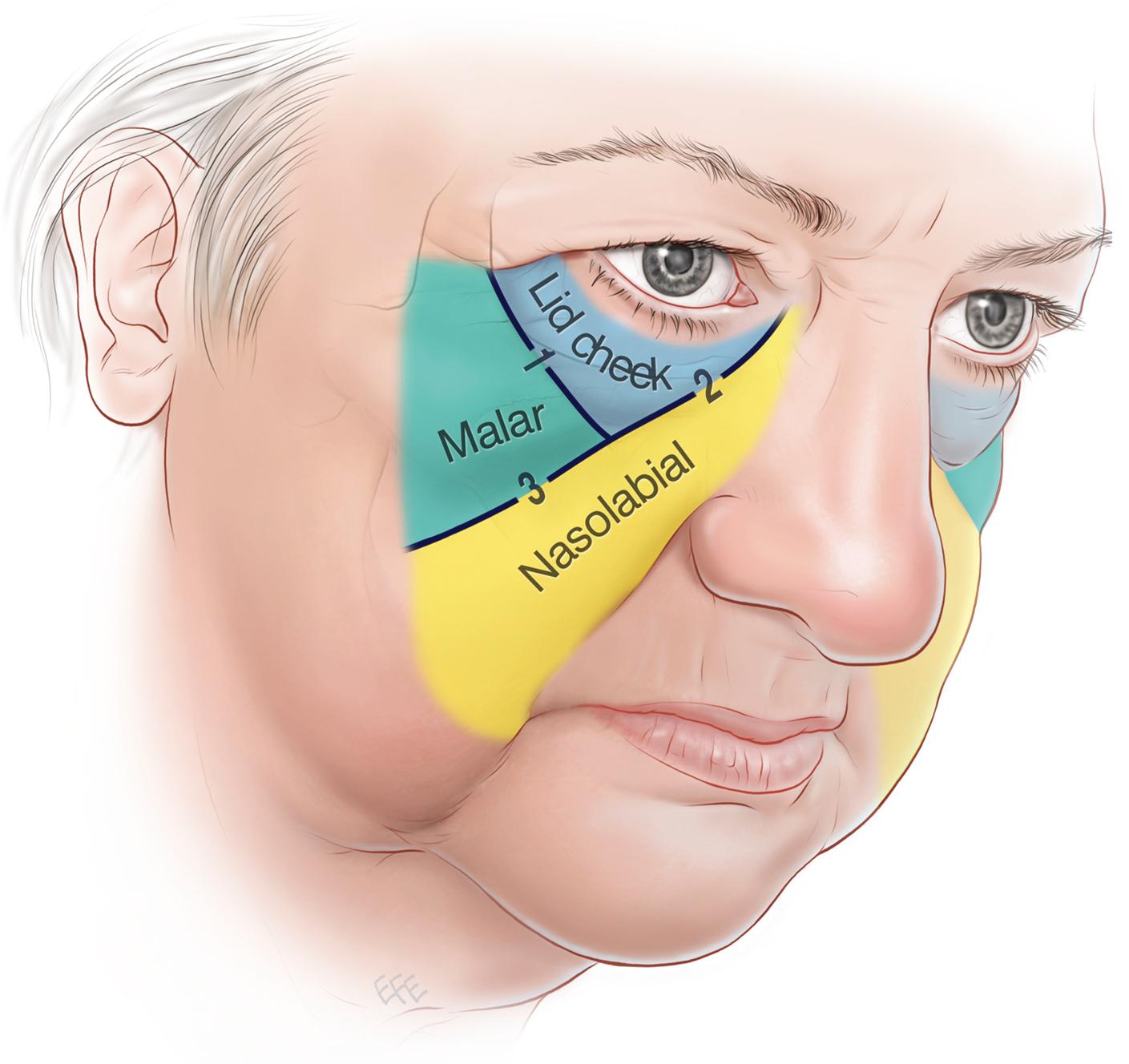Physical Address
304 North Cardinal St.
Dorchester Center, MA 02124
The authors would like to thank Associate Professor Michael Leung in the preparation of this chapter.
Defects of the cheek pose a challenge for the reconstructive surgeon. It is a mostly flat and relatively featureless terrain whose superficial appearance conceals a complex arrangement of fascia, arteries, and nerves. Its esthetic significance is associated with its contour, the preservation of which should be a priority for the reconstructive surgeon, though a carelessly-placed scar may also be disfiguring. Fortunately, it is also an area where the surgeon has a number of options for reconstructing defects with excellent functional and cosmetic results.
The cheek comprises one of the original esthetic units of the face as described by Gonzalez-Ulloa. It is bordered by the eye, nose, lips, chin, mandible, and ear. Functionally, it is important for mastication, swallowing, and speech. It forms a discrete esthetic unit of the face whose appearance was classically described by Menick as “a relatively flat, expansive surface, except for the soft roundness of the nasolabial folds and the cheek prominences,” that acts as a “picture frame” for the central face. As such, its contour is of utmost importance.
It is bordered by the infraorbital rim and zygomatic arch superiorly, the lower lid-cheek junction, nasofacial junction, nasolabial fold, marionette line, and labiomandibular crease medially, the mandible inferiorly, and the preauricular contours of the tragus and helix of the ear laterally.
Traditionally, the cheek may be divided into four subunits: medial, lateral, buccal, and zygomatic. , In some texts, infraorbital and parotidomasseteric subunits are described, which are roughly analogous to the medial and lateral subunits, respectively. Taken together, the medial, zygomatic, and buccal subunits constitute the midcheek.
Work by Mendelson has redefined the midcheek by taking into account fascial spaces and retaining ligaments identified in anatomical studies ( Fig. 28.1 ). He divides the midcheek, which is itself defined as the area between the lower eyelid and nasolabial junction, into the lid-cheek, malar, and nasolabial segments, separated by the palpebromalar groove and nasojugal groove. This categorization more faithfully reflects the transition between the thin skin of the eyelid and the distinct contours of the malar and nasolabial segments, particularly in the aging face.

The facial skeleton underlying the cheek consists of zygoma, maxilla, and mandible.
The layers of soft tissue in the cheek correspond to the basic five layers found in the scalp ( Box 28.1 ). From superficial to deep, the layers are skin, followed by a layer of dense subcutaneous fat which is separated into lobules enclosed by fibrous septa. The third layer, the superficial musculoaponeurotic system, or SMAS, was first described in 1976 by Mitz and Peyronie. The SMAS is continuous with frontalis superiorly and platysma inferiorly, between which it envelops the muscles of facial expression. There is another, looser layer of fat between this and the fifth layer, that of the periosteum or deep fascia, which is often absent in the face where the tissues do not overlie bone or skeletal muscle. In areas of the face not overlying bone, different layers are encountered. For example, in the parotid region this is represented by the parotid fascia, and in the buccal subunit of the cheek, the innermost layer is the buccal mucosa.
Dermis
Subcutaneous layer
Superficial musculoaponeurotic system (SMAS) layer
Loose areolar tissue
Periosteum and deep fascia, or buccal mucosa
Fascial structures provide an anchor between bone and skin and provide soft tissue contours throughout the body. Though there is no deep fascia in the face, the principle remains valid, with fascial condensations fixing the soft tissue of the face to the underlying facial skeleton. The retaining ligaments of the face were first examined by Furnas in 1989. He described several groups of ligaments, that remain essential to our understanding of the soft tissue structure of the cheek, contributing to the formation of the contour of the face ( Box 28.2 ). They have since been studied in some detail and are of particular relevance for esthetic plastic surgical procedures such as rhytidectomy. In reconstruction, it may be necessary to disrupt intact retaining ligaments in order to gain sufficient mobilization of flaps, or to recreate the effect of the retaining ligaments using deep sutures. They are discussed in greater detail in other chapters.
Tear trough ligament
Orbicularis retaining ligament
Zygomatic cutaneous ligaments (McGregor’s patch)
Masseteric cutaneous ligaments
Mandibular cutaneous ligament
Platysma auricular ligament
The majority of the muscles of the cheek are muscles of facial expression ( Box 28.3 ). They are embryologically derived from the second branchial arch and are supplied by the nerve of that arch: the facial nerve. The exception is masseter. As a muscle of mastication it is derived from the first branchial arch, and is supplied by the mandibular division of the trigeminal nerve. ,
Orbicularis oculi
Levator labii superioris
Levator labii superioris alaeque nasi
Depressor anguli oris
Risorius
Zygomaticus major
Zygomaticus minor
Platysma
Levator anguli oris
Buccinator
Masseter
Become a Clinical Tree membership for Full access and enjoy Unlimited articles
If you are a member. Log in here